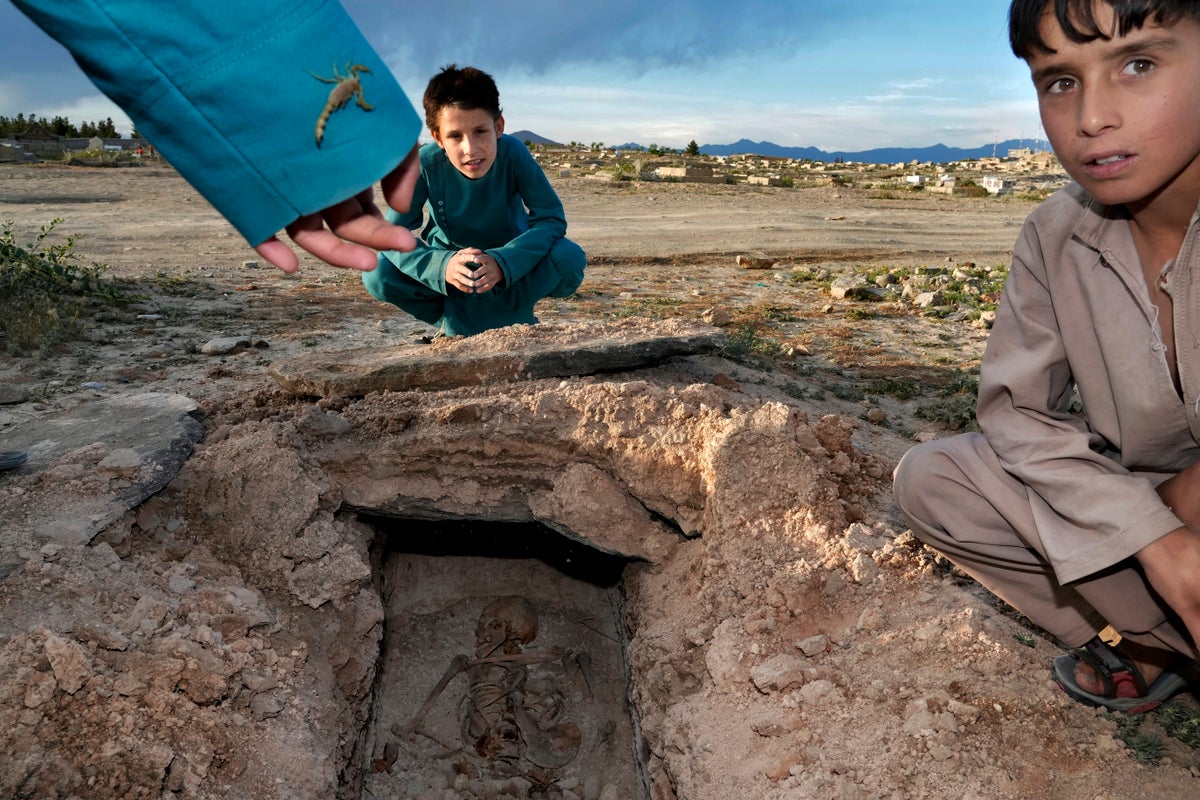
One of the graves had broken open in Kabul’s Nader Shah Hill Cemetery, exposing a near-complete skeleton at the bottom of the pit in the hard earth. The boys, who had been playing nearby, were not impressed.
“There’s a lot of ruined graves, it’s not unusual,” one boy, around 10, said with a shrug as they looked down at the bones. The only reason the kids came over, interrupting their soccer game, was to see what an Associated Press photographer was taking pictures of.
When asked if they were scared by it, the boy and his friends cracked up laughing.
“Why should we be afraid? A skeleton isn’t alive,” he said. “We see these every day.” It was no more startling than the scorpion that another kid showed off crawling on his sleeve.
There are cemeteries all over Afghanistan’s capital, Kabul, many of them filled with the dead from the country’s decades of war. They are incorporated casually into Afghans’ lives. They provide open spaces where children play soccer or cricket or fly kites, where adults hang out, smoking, talking and joking, since there are few public parks.
Some 50 years of war have transformed the capital, home to 5 million people. Many cemeteries have spread over the slopes of the barren mountains that rise up in the middle of the city. Other graveyards are close to upper-class neighborhoods or along the sides of roads.
During the vicious civil war of the 1990s, when multiple factions fighting for power bombarded Kabul, killing thousands, people often buried their dead right next to their houses because they were afraid to go out far. With time, those individual burials expanded into graveyards, melding with the neighborhood and with residents’ daily lives. People might be gathered celebrating a wedding while not far away mourners are gathered to bury a body.
“I was born here, and I always see graves,” said Habib, a 14-year-old, playing soccer with friends among the dead at Nader Shah Hill. Many of those buried here died in the nearly decade of fighting against the Soviet occupation in the 1980s. The old graves here are rarely maintained, so often the ground caves in or concrete tombs crack open.
For Kabul’s growing ranks of impoverished, the cemeteries can be a source of income.
Arefeh, 27, lives with her four children next to the Sakhi graveyard, used by the city’s Shiite minority. She and her kids make a bit of money selling water to passers-by and by washing graves. Like many Afghans, she goes by only one name.
The Shuhada-e Saliheen —- or “Virtuous Martyrs” — cemetery rolls down the slopes of a hill in southern Kabul, one of the biggest cemeteries in the city.
Fahim was born next door to the cemetery 54 years ago and was raised there, playing among his family's graves. His father and grandfather are buried nearby. Now his children, also born here, play in the cemetery.
He said he worries how it effects the kids. “Children grow up seeing bodies. Dying has become normal for them,” he said. “But we have no choice. We must continue this life.”
Hamed, an 18-year-old, was also born nearby. “In the early days, I would get scared when I went into the graveyard. But over time, it became normal.”
Now Hamed works as a gravedigger.







